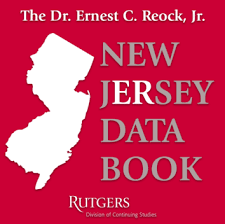
The Dr. Ernest C. Reock, Jr. New Jersey Data Book is a free data tool that provides users with fast, easy access to a variety of statistics and information about New Jersey.
The data we provide are gathered from numerous sources throughout the state and beyond, but what sets us apart is that our users can access this data all in one place.
Users are given the ability to create customized data tables based on their individual areas of interest. Geographies include all 565 municipalities within New Jersey, the 21 counties, 40 legislative districts, 12 congressional districts, and the state as a whole. Topics are organized within 12 indicators and are comprised of over 70 variables. Multiple years-worth of data is available so that users can view trends over time – some variables even date back to the 1980s.
For more information about the data available, visit the Explore Data section of this website.
History
Introduced in 2014, The New Jersey Data Book was introduced as a complement to the printed publication, the New Jersey Legislative District Data Book (NJLDDB). The NJLDDB was first published in 1976 by the Rutgers Bureau of Government Research, under the leadership of Dr. Ernest C. Reock, Jr., in an effort to give legislators a more accurate picture of the districts they represented. The NJLDDB provided maps, descriptions and a wide range of statistical data on each of New Jersey’s 40 legislative districts and the municipalities comprising them.
The foundation for the NJLDDB was laid early in the Bureau’s history in its research on legislative representation. In the 1950s, the Bureau called attention to inequalities in representation at a time when districts conformed to county lines. During that decade, Gov. Robert B. Meyner requested the Bureau study New Jersey’s Congressional Districts. The resulting report examined the history of such districts and proposed four plans for their revision.
In the 1970s, when county lines no longer served as legislative district boundaries, the Bureau began to compile statistical data based on these newly drawn districts. The resulting NJLDDB quickly became a trusted resource for government, citizens, the media and researchers. The 38th edition of the NJLDDB published in 2014 marks the last printed edition. Today, the New Jersey Data Book strives to provide not only historical statistics about New Jersey, but also the most current data available in a wide range of topic areas. Its growth continues to flourish. No other source of New Jersey data captures the historical trends reflected here.
About the Center for Government Services
Through its research, training programs and service to New Jersey, Rutgers Center for Government Services (CGS) has promoted professionalism and excellence in state, county and local government for more than 60 years.
CGS' roots date back to 1950, when Rutgers established the Bureau of Government Research to provide in-service training, conduct research, serve as a clearinghouse for information and offer technical assistance to government agencies.
In 1991, the Bureau of Government Research and the Rutgers Department of Government Services were combined to form the Center for Government Services, which continues to advance the original mission on behalf of New Jersey, its citizens and institutions.
For further information about the Center for Government Services, please visit cgs.rutgers.edu.